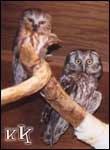 |
 |
| Adult |
Juvenile |
Northern Saw-whet Owls belong to the genus Aegolius - a genus represented by only one other species in North America - Boreal Owls (Aegolius funereus). Unsurprisingly, Saw-whets are very similar in appearance to their cousins, both as adults and as juveniles. The easiest method of distinguishing between these two small, yellow eyed owls is by beak colour: Saw-whet beaks are black while those of Boreals are bone to yellow in colour. Saw-whets are also smaller and a close examination of the crown will show white streaking rather than spotting (a Boreal Owl trait).
 |
A
Saw-whet on the left, a Boreal on the right. |
Juveniles of these species are particularly difficult to separate. Both have dark facial discs and tan breasts. Young Boreals have darker faces than Saw-whets though, and lack the bold white triangular "eyebrow" (and of course, have pale beaks). By late fall, first year birds begin moulting into adult plumage; a transition that may not be complete for several years as only certain flight feathers are replaced each year. By winter, however, these young owls look almost identical to adults. Below are photographs of a hatch year Saw-whet as it moulted from its juvenile plumage.
 |
 |
 |
 |
July
19 |
September
8 |
September
16 |
October
25 |
Saw-whets are one of few North American owl species that migrate seasonally (unlike the nomadic, or wandering, behaviour of Hawk Owls (Surnia ulula) and Snowy Owls (Nyctea scandiaca) ). Like many songbirds, these owls travel south in autumn and return to breeding areas in spring. Saw-whets are probably the most regularly banded owls on the continent. Because these birds fly low as they migrate and tend to bottleneck through narrow corridors in certain areas (creating a large number of owls in a small area), specially licensed banders can set up mist nets (fine netting bird banders use to trap small birds for banding) to trap the owls. They take a wide range of measurements including weight, wing chord (length from wrist to longest primary feather), fat score and age, before releasing the bird. These measures are used to gain a better understanding of Saw-whet populations, movements and the species as a whole.
Both Saw-whets and their larger cousins, the Boreals, are cavity nesters. They utilize both natural cavities and those excavated by woodpeckers and other small animals to lay eggs and raise their young. At The Owl Foundation, each Saw-whet pair is provided with several nesting options. These range from hollowed out trunks to man-made nestboxes and all are lined with soft layers of cedar shavings and pine needles. Young Saw-whets are placed with these foster parents.
While southern Ontario winters are usually bearable, staff at The Owl Foundation make sure all migratory and southern owls are comfortable. Saw-whet cages are all outfitted with heat lamps. These are set on dimmer switches and can be turned up or down by staff depending on external temperatures. Air heated by the bulbs is perfect for warming small owls. On very cold days we can usually find one or two birds sitting on branches below the lamps.
The Owl Foundation receives more Saw-whets in autumn than at any other time of year. The majority of these are young birds attempting their first migrations - hit by vehicles or having collided with buildings. Most Saw-whets are forced to fly through cities that disrupt natural migratory routes. Glass buildings are unperceivable barriers (reflecting sky back at birds) and owls, colliding with them, are found injured or dead on sidewalks.
Vocalizations:
This species supposedly
received its name from the sound of its alarm vocalization, "skiew!",
that sounds much like the whetting of a saw (1).
However, there is another theory - that "saw-whet" is derived
from the French word "souette" meaning "little owl"
(2).
Unfortunately (perhaps), none of our Saw-whets has been so upset as to
utter anything that sounds like "skiew". Pook, a blind and neurological
female, will periodically make twittering noises when disturbed though.
Recently we admitted a young fledgling who may have put this question
to rest once and for all. This little female routinely produces a raspy,
insect-like sound (below) when "presented" with dinner (a live
brown mouse she needs to hunt). She vocalizes repeatedly prior to hunting.
Juveniles of other owl species will cry to parents when presented with
food, hoping to get an easy meal from Mom or Dad. When this fails, young
learn to hunt their own meals. Although the call this little Saw-whet
produces sounds nothing like the "reaping" of other owl species,
it may nonetheless be a juvenile food begging call.
Below is the typical tooting
breeding vocalization of the Northern Saw-whet Owl. This repetitious series
of toots can continue for minutes on end if the owl is not disturbed and
can often be heard on and off all day and night in spring.
Vocalizations |
||
|
|
||
| Used
to woo a mate. |
||
Breeding |
||
| Presumably the vocalization this species was named for. At TOF, only young juveniles make this call. It seems to be linked to food presentation suggesting that it may be a food begging cry. | ||
|
|
||
|
|
||
(1) The
Owl Pages
(2) Soarin'
Hawk Raptor Rehabilitation
Contact
Us | Hours | Home
| Legal
© 2008 The Owl Foundation
Owl vocalizations recorded by Kara Kristjanson.
Unless otherwise stated, all photographs and sound files are the property of The Owl Foundation.
No images or sounds on this website are to be duplicated in any way without express written permission
from the party to which they belong.
If you are interested in receiving quality versions, please contact The Owl Foundation.
